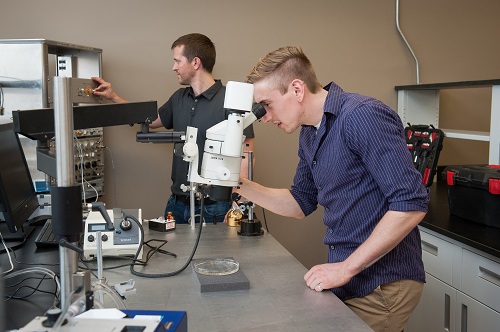Autonomic Neurophysiology Laboratory
Director: Dr. Steven Copp
Lab Overview:
My research laboratory investigates the pathophysiological mechanisms that result in thin fiber skeletal muscle sensory neuron hyperexcitability during exercise in various forms of cardiovascular disease. This area of research is important because these sensory neurons provide exaggerated feedback signals to the brain which produces exaggerated increases in sympathetic nervous system activity and blood pressure; both of which are predictive of cardiovascular disease morbidity and mortality. Our goal is to identify novel cellular mechanisms that produce that sensory neuron hyperexcitability thus identifying targets for therapies and treatments that may benefit the health and longevity of cardiovascular disease patients.
Lab Objectives:
- Autonomic nervous system control of the circulation during exercise in health and disease
- The exercise pressor reflex in cardiovascular diseases including heart failure and peripheral artery disease
- Mechanisms of muscle sensory neuron hyperexcitability
- Physiological and pathophysiological roles of mechanically activated channels on sensory neurons
Lab Personnel:
| Ashley Baranczuk | Undergraduate Researcher |
| Raimi Carroll | Undergraduate Researcher |
| Josie Larson | Undergraduate Researcher |
Current Projects:
- Exercise pressor reflex dysfunction in heart failure: mechanisms and treatment (NIH R01 grant)
- Signaling pathways regulating mechanoreflex sensitization in cardiovascular disease (NIH R01 grant)

Selected Publications
- Butenas ALE, Ishizawa R, Rollins KS, Mizuno M & Copp SW (2023). Sex dependent attenuating effects of capsaicin administration on the mechanoreflex in healthy rats. Am J Physiol Heart Circ Physiol 325(2): 372-384.
- Butenas ALE, Copp SW, Hageman KS, Poole DC & Musch TI (2023). Effects of co-morbid type II diabetes mellitus and heart failure on rat hindlimb and respiratory muscle blood flow during treadmill exercise. J Appl Physiol 134(4): 846-857.;
- Butenas ALE, Rollins KS, Williams AC, & Copp SW (2023). Bradykinin 2 receptors contribute to the exaggerated exercise pressor reflex in a rat model of simulated peripheral artery disease. Am J Physiol Regul Integr Comp Physiol 324: R183-R195.
- Butenas ALE, Rollins SK, Hammond ST, Ade CJ, Hageman KS, Musch TI & Copp SW (2022). Novel mechanosensory role for acid sensing ion channel subtype 1a in evoking the exercise pressor reflex in rats with heart failure. J Physiol 600(9): 2105-2125.
- Butenas ALE, Rollins KS, Williams AC, Parr SK, Hammond ST, Ade CJ, Hageman KS, Much TI & Copp SW (2021). Exaggerated sympathetic and cardiovascular responses to dynamic mechanoreflex activation in rats with heart failure: Role of endoperoxide 4 and thromboxane A2 receptors. Auton Neurosci 232: 102784.
-
- Smith JR, Hirai DM, Copp SW, Ferguson SK, Holdsworth CT, Hageman KS, Poole DC & Much TI (2021). Exercise training decreases intercostal and transversus abdominis muscle blood flows in heart failure rats during submaximal exercise. Respir Physiol Neurobiol 292: 103710.
- Rollins KS, Butenas ALE, Williams AC & Copp SW (2021). Sensory neuron inositol 1,4,5-trisphosphate receptors contribute to chronic mechanoreflex sensitization in rats with simulated peripheral artery disease. Am J Physiol Regul Integr Comp Physiol 321(5): 768-780.
- Butenas ALE, Rollins KS, Williams AC, Parr SK, Hammond ST, Ade CJ, Hageman KS, Musch TI & Copp SW (2021). Thromboxane A2 receptors contribute to the exaggerated exercise pressor reflex in male rats with heart failure. Physiol Rep 9(18): e15052.
- Rollins KS, Butenas ALE, felice KP, Matney JE, Williams AC, Kleweno TE & Copp SW (2020). Thromboxane A2 receptors mediate chronic mechanoreflex sensitization in a rat model of simulated peripheral artery disease. Am J Physiol Heart Circ Physiol 319(2): H320-330.